The first subway in America was built in Boston, Massachusetts in 1897.
The Boston subway was built during the second phase of the Industrial Revolution in Massachusetts and was very much a product of the technological advances made during that time, according to the book Encyclopedia of Twentieth Century Architecture:
“The subway is a 19th-century idea realized largely in the 20th century. The industrial revolution was the primary catalyst for the advent of underground transportation; without it the iron horse that pulled the trains, the tunneling technology that bored through the earth, and the iron walls that held those tunnels up would have been impossible.”
The Boston subway only came about due to the specific invention of the electric motor in the late 19th century.
Since Americans were not keen on the idea of a subway like one in London, England, which was a steam train that ran in dark tunnels and spewed ash and soot everywhere, an alternative method of generating power would be needed to build a subway in the U.S.
Fortunately, an American inventor named Frank Sprague solved this problem when he invented an electric motor in 1886.
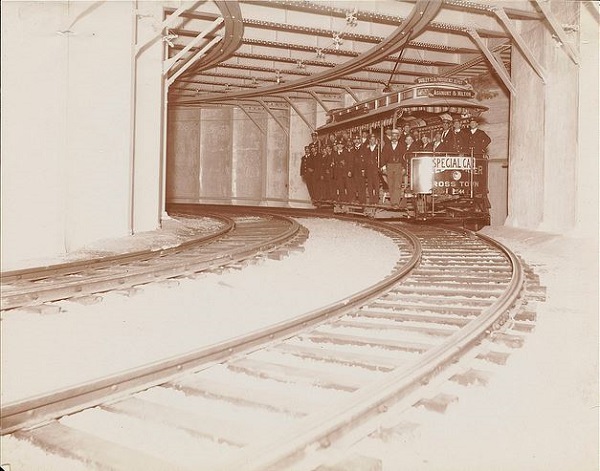
Test run on the Boston subway at Park Street Station on September 1, 1897
After Sprague successfully installed his motor in trolleys in Richmond, Virginia, in 1888, it prompted Henry Whitney, the owner of the West End Railway in Boston, Mass, to upgrade his trolleys to run on electricity the following year.
This experiment in clean energy is what later made it possible to convince lawmakers, businessmen and the general public that it was feasible to run these electric trolleys underground in Boston.
Why Did Boston Need a Subway?
Boston had a significant problem with congestion in its streets due to overcrowding issues and frequent blizzards and storms clogging up the city’s small, winding colonial-era streets.
Street congestion became such a problem that city officials began brainstorming ways to alleviate it, according to the American Society of Civil Engineers Website:
“By the 1890s, the transportation infrastructure of downtown Boston – a maze of narrow, winding streets laid out, in some cases, along Colonial cow paths – proved completely inadequate for the needs of a modern, bustling metropolis. Tremont Street, the city’s main thoroughfare, was regularly subject to gridlock from a convergence of foot traffic, horse-drawn conveyances, trolley lines, and electric streetcars. To rectify the problem, the Boston Transit Commission, with Howard A. Carson as chief engineer, was created in 1894 to study remedies.”
Contributing to the congestion problem was a recent influx of immigrants from Ireland, Italy, Germany and Eastern Europe, according to the book Beneath the Streets of Boston:
“Boston’s traffic problems surfaced during the 1890s, but their roots stretched back half a century to the years when the city’s population truly began to explode. During the 1840s, Boston was the first stop in the New World for thousands of desperate and hungry immigrants fleeing Ireland’s disastrous potato famine. A steady stream of immigrants from Italy, Germany, and Eastern Europe added to the numbers, and in just ten years Boston’s population swelled from 90,000 to 135,000.”
Public transportation at the time was practically nonexistent so city officials began creating horse-drawn trolleys, which were later replaced by electric trolleys, to accommodate the growing population.
These trolleys, combined with pedestrian traffic, private horse-drawn carriages and cabs as well as commercial wagons, created daily traffic jams in the streets.
Planning the Boston Subway:
City officials felt the best solution to this traffic problem was to build an underground subway and promptly began to lay the groundwork for a new transit system.
Since building a subway underneath the city streets involved a lot of red tape, in 1891, the City Council authorized the formation of a Rapid Transit Committee and the state legislature passed an act allowing for the formation of a committee to promote rapid transit in the city.
The Rapid Transit Commission consisted of eight members:
Nathan Matthews, Jr, Mayor and Chairman
William Jackson, City Engineer
John Quincy Adams
Chester W. Kingsley
Osborne Howes, Jr.
Major Henry L. Higginson
James B. Richardson
John E. Fitzgerald
Some of these members went abroad to England, Germany and France to study transportation methods there and, after nine months of study, filed a report to city officials in April of 1892 recommending a number of projects.
One of the projects they recommended was a small-scale subway located at the most congested areas: between Tremont street, Boylston street and Scollay Square.
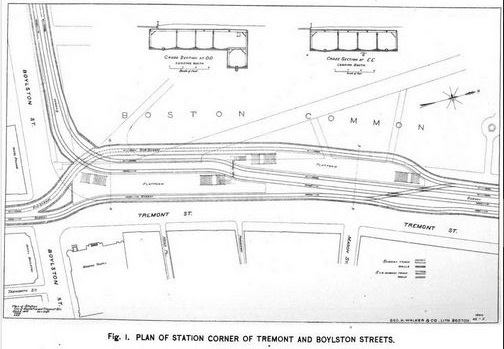
Plan of Station Corner at Tremont and Boylston streets, illustration published in Annual Report of the Boston Transit Commission, circa 1895
The plan for the subway was to link the underground subway tracks with the existing street tracks of the West End Street Railway in South and West Boston and with the street tracks of the Lynn and Boston Railway in North Boston.
This would allow the subway to run on the surface streets in the less congested areas of the city and underground in the more congested areas to reduce street traffic above.
In 1893, the Legislature passed two acts. The first act called for the formation of a Metropolitan Transit Commission but was promptly rejected by voters at the state election.
The second act allowed for the formation of a Board of Subway Commissioners that was authorized to lay out and construct a subway from Tremont Street to Pleasant Street. This act was approved by Boston City Council on January 1, 1894.
In 1894, the Legislature passed an act which allowed for the incorporation of the Boston Elevated Railway, a privately owned company that would be responsible for building and running an elevated railway line, and also called for the creation of the Boston Transit Commission, which was the first public transportation agency in America.
The members of the Boston Transit Commission were:
George Glover Crocker, Chairman
Howard A. Carson, Chief Engineer
Henry H. Carter, Consulting Engineer
B. Leighton Beal, Secretary
Albert C. Burrage
Charles H. Dalton
Thomas J.Gargan
George F. Swain
The commission was authorized to build a number of subway lines, according to the Special Publications periodical:
“The Commission was authorize but not required to construct: (1) a subway or subways of sufficient size for four railway tracks through and under Tremont street and the adjoining mall of Boston Common from a point near the junction of Tremont street and Shawmut Avenue to Scollay Square and thence to Causeway street; (2) a subway of sufficient width for two tracks only from Tremont street and through and under Boylston street and the adjoining mall of Boston Common to a point on Boylston street where a suitable connection with the surface tracks could be made, and from Boylston street through and under Park Square and Columbus avenue, to a point on Columbus avenue where a suitable connection with surface tracks could be made: (3) a subway from Tremont street through and under Park street, Temple street, and Staniford street to Merrimack square; and (4) a tunnel from a point on or near Scollay square to a point on or near Maverick square in East Boston. They were also required to construct a bridge to Charlestown. The act further authorized an issue of bonds to the amount of $7,000,000 for the construction of subways and a sufficient sum, in addition to $750,000 already appropriated by the City Council, to complete the Charlestown Bridge.”
The act was approved on July 2, 1894 and accepted by the voters of Boston in a special election held on July 24, 1894.
While planning the layout of the Boston Subway, the Boston Transit Commission became aware that parts of the Central Burying Ground near Boylston Street possibly lay in the path of the subway.
The Commission asked Dr. Samuel Green, the former Mayor of Boston and the librarian for the Massachusetts Historical Society, to write a report about the history of that plot of land and asked for advice on what to do with any unearthed remains.
In addition, the Commission also asked Green if there was any health risk involved in unearthing dead bodies. Green submitted the following report on December 20, 1894:
“This parcel of land was bought by the town in the year 1756 for a place of interment, and since then it has continued to be used for that object. The first burials were made in graves, and, so far as now can be ascertained, the earliest tombs were built about 1793. Some years later Frog lane was widened, and became Boylston street, as it is known to-day. In 1836 Boylston-street mall was laid out, and, in order to straighten the path, the mall was raised and carried over a line of tombs which stood in the way. At this time some of these tombs were emptied of their contents by the owners, while others were filled up, the remains being taken either to the new tombs built on the westerly side of the ground or to other cemeteries, or were covered up, where it was supposed they would lie undisturbed until they were completely decomposed and mingled with the surrounding soil.
There is some reason to think that, when the burying ground in question was first used as such, a few of the interments were made outside of the present limits of the Common, and presumably where the street now runs. Within the past few weeks Boylston street, on its north side near the fence, has been dug up by the Boston Electric Light Company; and I am told by creditable persons that fragments of human skulls and other bones were thrown out by the workmen. It is possible, of course, that these remains came originally from the Common, and were scattered with the earth either when Boylston street was graded or when the mall was laid out.
A subterranean passage or tunnel, under the mall along the southern border of the Common, would probably disturb the bones of many an old Bostonian, but this now cannot be helped. At the present time the question is a practical one, if the proposed plan for a subway is to be carried out, and the removal of the remains becomes a necessity. All rights in these hidden tombs, on the part of their former owners, have long since been extinguished, and no injustice would be done to the living representatives of their several families by a reburial of the remains. It goes without saying that such action, under the guidance of your Board, would be decently and respectfully done. With that end in view I would recommend that all such traces of the human body as may be found in these excavations should be carefully gathered up and placed in proper receptacles for their reinterment in the same burying ground, where presumably repose the ashes of the kindred, and that this suggestion be carried out with the same regard for the feelings of friends — so far as is practicable under existing circumstances — as was shown at the original burial, and as if each bony fragment was now fully identified with the person to whom it formerly belonged.
In regard to your question concerning risk from infection or contagion as a result of the last illness of the decedents, I would say that there would be no danger whatever to the workmen. The earth is a good disinfectant, and a burial of more than half a century would wipe out and destroy any germs of disease that might still linger after death.”
Another obstacle the Commission faced was a number of private properties that lay in the path of the proposed subway lines. In order to overcome these obstacles, these private properties were seized by the city.
Some of these properties include a large block of property bound by Haymarket Square, Canal street, Causeway street and Haverhill street, and another block of property bound by Shawmut avenue, Pleasant street, Tremont street and Warrenton street.
A block of land between Canal and Haverhill streets that was owned by the Boston & Maine railroad was taken by the city in 1894 and the company was awarded $750,000 in damages for the seizure in 1895.
A block of land bound by Shawmut avenue, Pleasant street, Tremont street, Warrenton street, that consisted of three private estates, was taken by the city in 1895 and the city paid $348,427 in damages in 1898.
Opposition to the Boston Subway Plans:
According to testimony given by George G. Crocker, Chairman of the Boston Transit Commission, to the members of British Parliament in October of 1903 (Britain was considering building an elevated railway in London and sought the advice of the Boston Transit Commission) the initial reaction to the idea of a subway in Boston was negative:
“The act which authorized us to build it did not compel us to build it, and when we decided to build it there was a great public uproar and meetings in Faneuil Hall and the Legislature came very near repealing the Act. The newspapers were against us: the steam railroad men smiled at the idea; and the West End Street Railway Company, which was then operating all these lines in the City, said ‘Very well, you can go ahead and build it; we will never be willing to pay anything for it; the Legislature may oblige us to use it, but we never can afford to pay anything for it:’ But when we got it about half completed, the West End Railway Company began to negotiate with us for a lease of it.”
Opposition was so strong that over 12,000 businessmen signed a petition against the construction of the subway and an anti-subway league was even formed.
Some members of the public were also skeptical about the idea of traveling underground because it was a place associated with death and burial. This was a constant theme during the entire length of the project and it didn’t help when the construction later unearthed graves from the old Central Burying Ground.
Many people also believed that the air quality underground was poor and that people would became sick from breathing in the air. Some residents complained during construction that the work was poisoning the air and killing the trees in the Public Garden, according to an article in the Daily Advertiser in the summer of 1895:
“Some of them have died. Why should this foul, poisonous sod be laid out in the city’s parks to perfume the neighborhood and spread disease germs over the surrounding regions?”
These complaints were few though and opponents of the project were viewed by the general public as backwards and old-fashioned people who stood in the way of progress.
Construction of the Boston Subway:
On March 28, 1895, the Chairman of the Commission, the Massachusetts Governor Frederick T. Greenhalge, Boston Transit Commission Chairman George G. Crocker and other members of the Commission broke ground on the project in a special ceremony in the Boston Public Garden.
The construction process first called for a large 2,300 pound pile driver to hammer the ground and loosen the dirt so workers could shovel it into carts and carry it away.
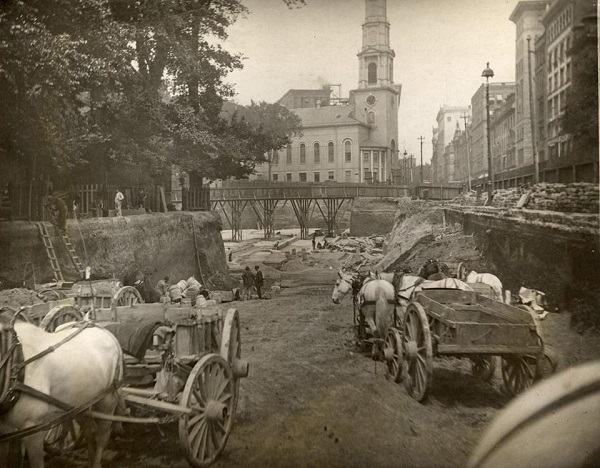
Workers building the Boston subway in 1895
Then the engineers combined two different types of construction to build the tunnels: the underground “tube” style of construction used in London and a newer open-excavation method used in Paris.
In order to keep Tremont street open during the day, as required by the act of 1894, the Commission combined these two techniques to create their own construction technique which became known as the cut-and-cover technique.
In this technique, trenches were dug in sections of about 10 feet long, 12 feet wide and six feet deep. Wood braces were then installed to prevent the dirt from caving in and were placed across the top of the trench to create a roof for bricks to be laid.
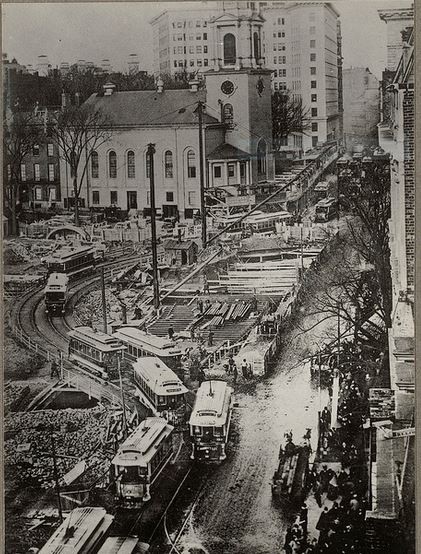
Subway construction at Park Street Station, Boston, Mass, circa 1895-97
Workers continued to dig the trench deeper and once it was deep enough, steel support beams were placed along the sides of the walls and along the top, perpendicular to the tracks.
Workers then built the walls and floors with concrete reinforced by the steel beams and added waterproof grout. Masons and steelworkers then constructed the roof of the tunnel by building brick arches between the steel support beams and finished the upper surface with a layer of concrete and soil.
Although the London subway tunnels were between 100 and 200 feet down, the Boston subway tunnels were only 50 feet down. This was done so the tunnels could be build faster, it produced less dirt to cart away and it reduced the risk of damaging the foundations of neighboring buildings.
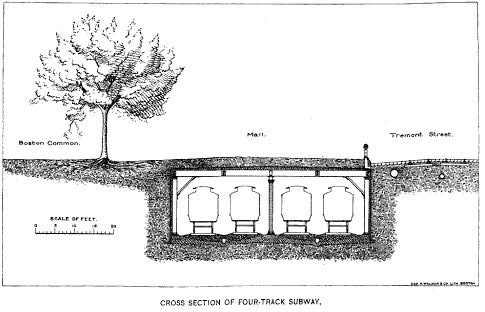
Cross Section of Four Track Subway, illustration published in Annual Report of the Boston Transit Commission, circa 1895
The cut-and-cover technique was so successful that there was very little interruption to the street traffic above. This technique later became the standard practice in nearly all American subway construction.
Boston Subway Construction: Accidents, Damages and Discoveries:
According to Crocker, the Chairman of the Boston Transit Commission, in his testimony to Parliament, building the subway in the areas of Boston built on a landfill was especially difficult and caused slight damages to the foundations of nearby buildings:
“We did some injury, but it was slight. Construction was specially difficult from Adams Square North; that is all filled or made land. Nearly all of the buildings are built on piles and they were built many years ago. The piles were of all varieties, and all lengths, some long, some short, and our subway in that part of Washington Street being for four tracks, occupied practically the whole width of the street. There was one place up in Tremont Street where one building was slightly cracked, but the actual cost of repairing damages to buildings was less than ten thousand dollars.”
In addition, about a month into the construction, on April 18, 1895, workers uncovered human remains under Boylston Street, just as Dr. Green suspected they would.
According to the book A City So Grand: The Rise of an American Metropolis: Boston 1850-1900, the bones were originally discovered by college students exploring the construction site and when the workers began collecting the bones and piling them up on a retaining wall near the construction site in plain view of passersby, word began to spread:
“The first human remains were discovered twenty-four hours earlier when a medical student poking around the construction had stepped on something hard that gave way with a loud snap. Believing he had broken a stick, the student had scratched away some dirt with his boot, reached down, and picked up the object, only to find it was a human thighbone. Moments later, others students found a skull, the disjointed parts of two arms and hands, and crumbling bits of bones scattered in the area. Things had deteriorated from there. Workers unearthed additional bones and began piling them carelessly against a retaining fence adjacent to Boylston Street at the southwest entrance to the Common. Passersby watching the construction had blanched at the sight and began spreading word of the grisly discovery. In the evening, vandals had entered an unguarded open tomb, removed human remains, and paraded around the Common, led by one grinning youth holding aloft a skull as the others followed. Neighbors finally contacted the police, who put a stop to the demonstration.”
As Dr. Green previously predicted, the remains were from the Central Burying Ground on the edge of Boston Common. When the street was widened in 1836, Green suspected that workers built the road over the bodies instead of re-interring them elsewhere.
The day after the discovery, the Commission contacted Dr. Green to take control of the newly discovered remains, according to a report written by Dr. Samuel Green on July 27, 1895:
“On April 19th my attention was first called to the discovery of various parts of several skeletons, which were found during the forenoon of that day, or the afternoon of the preceding day, lying outside of the tombs. Steps were taken at once for the proper care of these fragments, and boxes were ordered for their final disposition. Apparently the bodies had been placed originally in the ground, though there was left hardly any trace of coffins; and it seemed probable that many of the bones had been previously disturbed. This incident was but the beginning of the discovery of other remains, which continued daily in considerable numbers for several weeks. The various parts of the skeletons were so incomplete that it is impossible now to say with any exactness how many different persons they represented, but an approximation to the number is given later in this report. In some cases the fragments were very small, and, if found elsewhere, would not have been recognized as belonging to the human frame. The special duty of collecting these remains was assigned by the contractors to two or three men who, I am satisfied, did their work faithfully; and, whenever practicable, they placed the bones of one body in a single box. In two instances (the Lowell and Tuttle tombs), where the remains in tombs were identified, they were taken by representatives of the two families, and reinterred elsewhere. During the progress of the excavations it was found that the line of buried tombs extended from a point near the entrance to the Common, at the south-west corner, to a point nearly opposite to the old Public Library. Some of the tombs had been almost entirely destroyed, while others were in a fair or good condition. Nearly all contained coffins, which for the most part were so decayed that they could not be handled, and the enclosed bones were much decomposed. In many instances the brick arches, that once served as the top of the tombs, had been broken in, and the tombs themselves partially filled with earth, bones, stones, and other matter, and then covered over with granite slabs. So confused were the contents that it was impossible to find out the number of original interments. It was evident that such tombs had been used for the reception of bones that had been disturbed in the surrounding ground when the mall was built.”
Green reported that at least 90 bodies were found in seven tombs, which had not been previously disturbed, and 820 bodies were found scattered around in the ground, resulting in a total of 910 bodies.
Some of the coffins and tombs were still intact and had legible inscriptions of the names and dates of the people buried there. The workers recorded the following names and dates from the coffins and tombs:
James T. Blanchard
Mrs. Sarah Blanchard
James Blanchard
Died Oct. 6, 1832
Ae. 5 years
Solomon Hawes
Died Jan. 30, 1834
Emmaline Evans,
Died Oct. 1, [date illegible]
Gideon Williams
Born Aug. 12, 1746
Died Jan. 23, 1830
[first name illegible] Tileston
Manshu Tucker
Died Oct. [date illegible] nth, 1800
Nathaniel Waer, Junr.,
Died Nov. 16th, 1823
Age 25 yrs
Charles H. Locke
Zeal Skidmore
Died Feb. 7, 1827
Ae. 49 years
Jane Hodgkins
Obt. Sept. 20, 1821
Aet. 54 years
Mary Parsons Haven
Died Oct. 20, 1827
Ae. 21 yrs
Samuel Morse
Died Jan. 4th, 1826
Age 56 years
Aaron Dexter
Mr. Willima Homer
Died Augt. 22d, 1822
Age 52 yrs
Homer Evans
Ae. 5 mos
Daniel Tuttle
Died May 10, 1823
Eunice V. Fuller
Died Oct. n, 1826
Ae. 42 yrs
lliam Keith Spence Lowell
Died, 1823
Mr. Rufus Tower
Died Nov. 29th, 1820
Age 63
Mrs. Lydia Kimball
Died Oct. 29th, 1821
Age 64 yrs
According to Green’s report, the remains were given to Lewis Jones & Son, an undertaker, for reburial in the Central Street Burying Ground. The undertakers chose a spot where the remains could be buried in a row by themselves without disturbing any of the other graves around them and a plaque was placed above the remains, which read:
“Here were interred the remains of persons found under the Boylston Street Mall during the digging of the Subway, 1895”
A few years later, on March 4, 1897, another, much bigger problem occurred. Just as the subway construction was nearing completion, a large gas explosion occurred at the corner of Boylston and Tremont streets after a break in an old gas main on Boylston street wafted into the air above and also filled the large subway tunnel below.
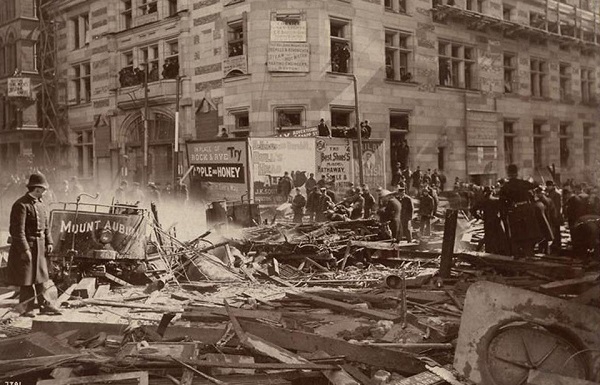
Explosion in Boston on Tremont Street after a spark from a trolley ignited a gas leak on March 4, 1897
Although the gas had been leaking for months and complaints had been made to the gas company as far back as December, the source of the leak was never found or repaired.
Then, on March 4, 1897, at 11:45 am, sparks from the wheels of a trolley turning the corner at Tremont street ignited the gas and set off a large explosion that killed 10 people, seriously injured 60 others and caused extensive damages to nearby buildings.
Despite the accident, the subway construction still went ahead as scheduled and was completed by the end of the summer.
Boston Subway Lines and Stations:
The initial construction of the Boston subway included three stations: Park Street, Public Garden and Boylston. The subway line was a little over half a mile long and was a three minute ride. The underground stations were connected to trolley tracks on the city streets and later to elevated tracks above the city streets.
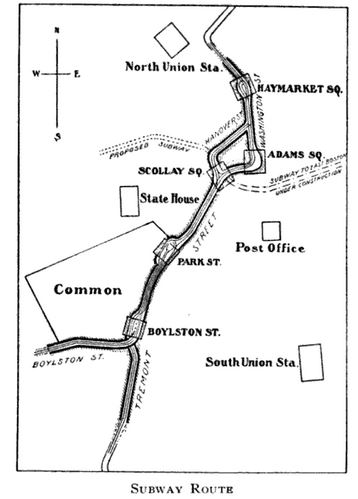
Subway Route, illustration published in Boston: A Guide Book, circa 1903
The two-track subway line between Park Street and Tremont street and the four-track subway line between Boylston street and Park street was finished in the summer of 1897 and opened to the public on September 1, 1897.
A four track triangle-shaped subway line from Pleasant street to Boylston street and a four track subway line from Tremont street to Hollis street and a two-track subway line from Hollis street to Boylston street was completed shortly after and opened on September 30, 1897.
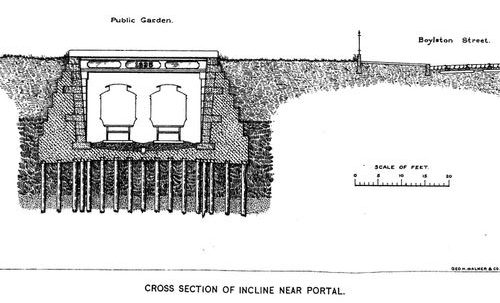
Cross Section of Incline Near Portal, illustration published in Annual Report of the Boston Transit Commission circa 1895
Construction on the Charlestown Bridge began in 1896 and was opened to the public on November 27, 1899.
Additions were added to the Boston Subway after initial construction was completed. In 1901, construction began on the East Boston Tunnel (which is now the Blue line). The tunnel ran under Boston Harbor, making it the first North American tunnel to run under a body of water. The tunnel opened on December 30, 1904.
Additional lines and stations have been added throughout the 19th, 20th and 21st centuries.
What Effect Did the Boston Subway Have on Street Congestion?
According to testimony given by the President of the Boston Elevated Railway Company, Major-General William A. Bancroft, to members of Parliament in 1903, the subway had only a moderate effect on reducing street traffic in the congested areas and may have actually increased foot traffic:
“I think there is some difference in the nature of the traffic; but it has not had much effect in reducing congestion. The congestion of the streets by cars [trolley cars] has all been removed; the general condition is somewhat better since the construction of the subway…I think you can get on faster on Tremont Street than ever. The vehicular traffic is considerably less….I think the sidewalks are more crowded; the street is not so much…I think there is a consequent increase of pedestrian congestion at times, through the number of people who travel now by the subway, where they come to the subway stations; many of them came into town by steam railroads years ago.”
In addition, Bancroft felt that the elevated railway was a much faster and more efficient mode of transportation than the underground subway itself:
“We carry them so much faster on the elevated road that on the subway. This Boston town bears out the tradition that its streets were marked by cows, they are so very crooked. When the Boston Transit Commission undertook the construction of the subway, in order to build the thing economically they followed the lines of the streets, and they are so crooked that you cannot run trains fast in the subway. In the six miles of road over which our elevated trains run (only a mile and a half is in subway) and with but two or three sharp curves, a train turns around nine times; in other words, there are something over 3,000 degrees of curvature and many grades, some of them 5 percent. The elevated road runs on the structures outside of the congested district, and when it reaches the congested district it dives down into the subway. The sharp curves and all the grades are in the subway and very numerous.”
How Much Did the Boston Subway Construction Cost?
The initial Boston Subway construction cost taxpayers a total of five million dollars. To be specific, according to Crocker in his testimony to Parliament, the first tunnels cost a little over four million dollars, altering the subway to adapt and connect to the elevated railways, which were completed in 1901, later cost $250,000 and the East Tunnel later cost three million dollars.
Sources:
Puleo, Stephen. A City So Grand: The Rise of an American Metropolis: Boston 1850-1900. Beacon Press, 2011.
City of Boston Statistics Dept. “Rapid Transit.” Special Publications Extraordinary Receipts and Expenditures – 1893-1897, No. 6, Boston Municipal Printing Office, 1900.
Cheape, Charles W. Moving the Masses: Urban Public Transit in New York, Boston, and Philadelphia, 1880-1912. Harvard University Press, 1980.
Most, Doug. The Race Underground: Boston, New York, and the Incredible Rivalry That Built America’s First Subway. St. Martin’s Press, 2014.
McKendry, Joe. Beneath the Streets of Boston: Building America’s First Subway. David R. Godine, 2005.
Great Britain Parliament. Parliamentary Papers, House of Commons and Command. Vol. 42, 1906.
Sennott, Stephen. Encyclopedia of Twentieth Century Architecture. Taylor & Francis, 2004.
Commonwealth of Massachusetts, State Transportation Library. “A Chronicle of the Boston Transit System.” Compiled by Greg Sanborn, Massachusetts Institute of Technology, 1992, web.mit.edu/cron/project/uncertainty/Dowd_Data/Baum_Snow/boston-history.txt
Boston Transit Commission. Annual report of the Boston Transit Commission, for the year ending August 15, 1895. Rockwell and Churchill, 1895, archive.org/stream/annualreportofbo11895bost/annualreportofbo11895bost_djvu.txt
City of Boston. “Transit Department Records.” City of Boston Archives and Management Division, cityofboston.gov/images_documents/Guide%20to%20the%20Transit%20Department%20records_tcm3-30031.pdf
“Boston Subway.” ASCE, n.d., asce.org/project/boston-subway/
Beirman, Noah. “Transit Archeology.” Boston Globe, 26 Dec. 2009, archive.boston.com/news/local/massachusetts/articles/2009/12/26/tour_of_abandoned_subway__network__offers_a_glimpse_of_how_the_t_was_built/
“History of the Boston Subway.” Boston Globe, archive.boston.com/news/globe/ideas/gallery/first_big_dig/
“Nation’s First Subway Opens in Boston September 1, 1897.” Mass Moments, Mass Humanities, massmoments.org/moment.cfm?mid=254
Most, Doug. “The Bigger Dig.” Boston Globe, 26, Jan. 2014, bostonglobe.com/magazine/2014/01/26/the-history-behind-boston-race-build-america-first-subway/jm0grRaspdAREUbDv4KXsI/story.html

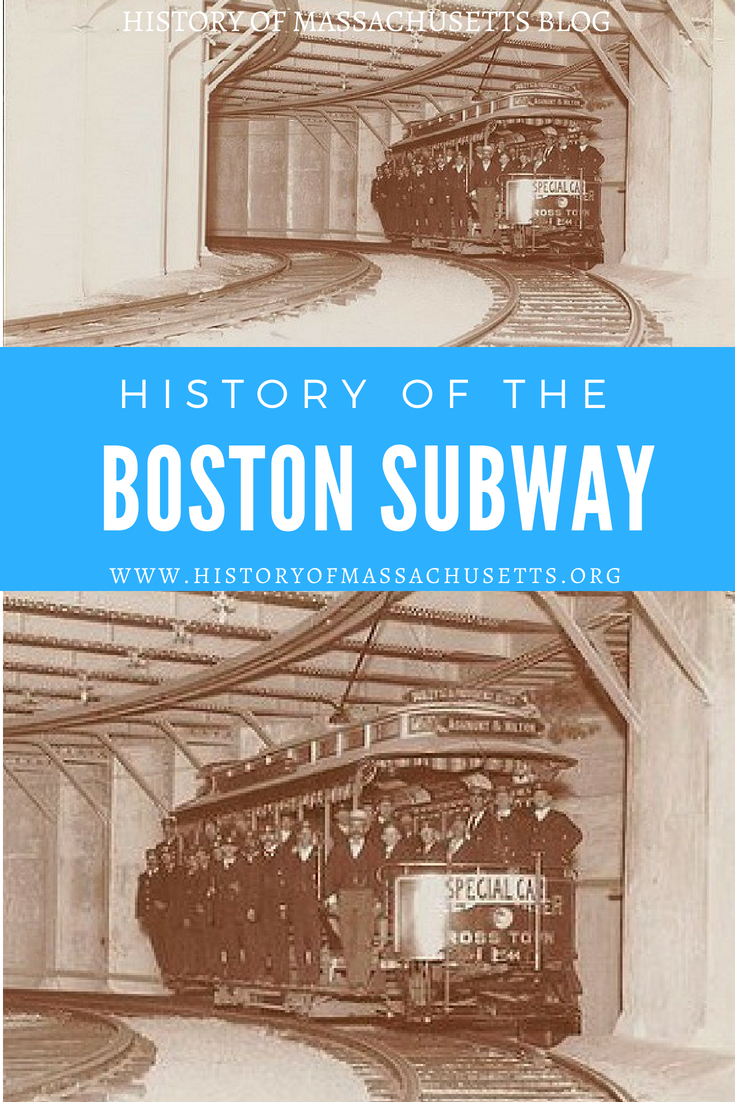
Enjoying your site. Very interesting.
Thank You
What a wonderful story! All the information is just incredible! It’s so sad about all the bodies that they found and the ones with dates were so young when they died! I count anyone dying before 60 as being young!
You did such a terrific job re-telling this fantastic piece of history.
Wonderful! This is the info I needed for my school report. Your amazing
I’m so glad you found this helpful.
I remember passing the main trolley depot at Cleveland Circle on the Green Line- in the 70’s. The yard still had trolleys dating back to the 1930’s and 40’s. It was like a living museum. As a matter of fact- there were still a few trolleys in service that dated back to at least the 50’s and possibly earlier. They were built to last. This is a lovely piece of research. Kudos.